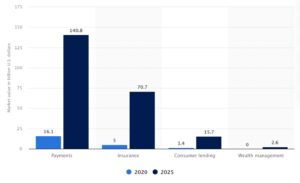
The Financial Services industry (FinServ) has embraced digitisation at a rapid pace - leading the way in implementing digitalisation strategies. Online and mobile banking is now the norm for much of the UK population and the rapid change in consumer demands has pushed banks to scale back their brick-and-mortar operations. For example, HSBC recently announced it will close 114 more branches in the UK from April.
However, while digitalisation brings numerous advantages to its users, there are still those that rely on in-person or telephone services and are unable to access digital services others might now take for granted. This digital exclusion has the potential to grow exponentially as branches are closed and those that have relied on traditional forms of banking, such as in-bank advice, cash and cheques face being left behind.
The cost-of-living crisis may exacerbate the issue as families seek to cut costs. While 60% of FinServ respondents within our recent research reported a great increase in demand for digital communication from customers as a result of the pandemic, 1.7 million households in the UK are still not connected to the internet. According to Lloyds Bank’s Consumer Digital Index, 9 million people cannot use the internet without help, and 11.7 million people lack essential digital skills for everyday life.
At the same time, three in four Britons lack trust and confidence in digital banking services. With groups such as the Good Things Foundation working with banks on schemes to close the digital divide, financial services must ensure that they are able to meet customers where they are - on and offline - while building trust and confidence in an array of service offerings.
Talking with customers on their terms
A sound digital strategy will not only focus on how best to employ new channels. It will ensure that the institution has the data it needs to understand customer communication preferences and act appropriately and efficiently on this information.
For example, our research shows that the top benefits FinServ organisations have gained through digitisation include deeper customer insights and improved customer experience. There is also a clear opportunity for the industry in how it communicates with customers. For example, a much higher percentage of other industries talk to customers through social media platforms. For example, 55% of other industries communicate with customers through Twitter, compared to just 30% in the FinServ sector.
The popular emergence of encrypted messaging platforms such as WhatsApp also means there is a real opportunity for FinServ to grow its digital communication channels, bearing in mind the data protection and cybersecurity implications this entails. Solutions that strike this delicate balance between security and ease of use are therefore well-positioned to assist financial services organisations looking to rethink how they communicate with customers while building trust. However, this is just the start.
When an institution knows a customer’s communication preferences it can tailor approaches and services accordingly, potentially closing gaps between the digitally engaged and the digitally excluded.
Digital helps meet diverse needs
There are a vast array of communications channels available to FinServs, both on and offline. However, it is in unifying these communications that will ensure universally strong customer experiences.
Whether in brand, online, via an app or through a letter, how institutions communicate with customers must be harmonised. 95% of FinServs agree that the ability to continue customer interactions across multiple channels would be valuable to their organisation. However, just 30% of FinServs report that they have fully implemented a unified communications-as-a-service (UCaas) solution at their organisation.
A lack of cohesion across different platforms can be jarring for customers and weaken customer experience. This applies as much to online platforms as it does to in-person interactions. The contact centre should represent an integrated approach to unified communications, bringing business experts and agents together, across every channel to deliver real-time customer experiences in a cloud-based, collaborative engagement model. Not only that, but a unified approach to customer communications also helps FinServs meet regulatory compliance and data security requirements in a holistic manner.
This same model empowers in-person experts to deliver next-level services to customers seeking personal in-branch advice and support - and to understand where they might be able to offer support and education around online services. For example, in-person branch experts could assist customers to sign up for digital services, as Lloyds has done with its free digital skills training programme.
Banks and financial institutions are a vital resource for all members of our communities. Taking a leaf from Lloyds’ book, this kind of community initiative demonstrates a customer-centric digital strategy that delivers for all. Alongside such education and awareness programmes, insight must be at the heart of decision-making, and that includes meeting the needs of a diverse customer base.
Digital, unified communications ensure customers are met where they are. Not only that, but by using insight from this unified system, banks can do more to ensure all customers are supported and empowered to access financial services while investing in schemes and services to ensure no one is left behind.
- SEO Powered Content & PR Distribution. Get Amplified Today.
- Platoblockchain. Web3 Metaverse Intelligence. Knowledge Amplified. Access Here.
- Source: https://www.finextra.com/blogposting/23462/making-sure-that-finservs-digital-transformation-doesnt-mean-digital-exclusion?utm_medium=rssfinextra&utm_source=finextrablogs
- 1
- 11
- 7
- 9
- 95%
- a
- ability
- Able
- access
- According
- accordingly
- across
- Act
- advantages
- advice
- agents
- All
- alongside
- and
- announced
- app
- approach
- approaches
- appropriately
- April
- around
- Array
- available
- awareness
- back
- Balance
- Banking
- Banks
- base
- behind
- being
- benefits
- BEST
- between
- book
- Branch
- branches
- brand
- Bringing
- Brings
- Building
- business
- cannot
- Cash
- centre
- change
- Channel
- channels
- clear
- Close
- closed
- closing
- collaborative
- communicate
- Communication
- Communications
- Communities
- community
- compared
- compliance
- confidence
- connected
- consumer
- contact
- continue
- Costs
- could
- crisis
- customer
- customer experience
- Customers
- Cut
- cut costs
- Cybersecurity
- data
- data protection
- data security
- Decision Making
- deeper
- deliver
- delivers
- Demand
- demands
- different
- digital
- digital banking
- digital services
- digital strategy
- Digital Transformation
- digitalisation
- digitally
- digitisation
- diverse
- Doesn’t
- ease of use
- Education
- efficiently
- emergence
- empowered
- empowers
- encrypted
- encrypted messaging
- engaged
- engagement
- ensure
- essential
- everyday
- example
- excluded
- experience
- Experiences
- experts
- exponentially
- Face
- families
- financial
- Financial institutions
- financial services
- Finextra
- FinServ
- Focus
- forms
- Free
- from
- fully
- good
- granted
- great
- Group’s
- Grow
- Heart
- help
- helps
- higher
- holistic
- households
- How
- However
- HSBC
- HTML
- HTTPS
- implemented
- implementing
- implications
- improved
- in
- include
- includes
- Increase
- industries
- industry
- information
- Initiative
- insight
- insights
- Institution
- institutions
- integrated
- interactions
- Internet
- investing
- issue
- IT
- Kind
- Lack
- leading
- letter
- Life
- Lloyds
- looking
- Making
- manner
- means
- Media
- Meet
- meeting
- Members
- messaging
- might
- million
- mind
- Mobile
- Mobile banking
- model
- more
- multiple
- needs
- New
- numerous
- offer
- Offerings
- offline
- ONE
- online
- online platforms
- Operations
- Opportunity
- organisation
- Organisations
- Other
- Others
- Pace
- pandemic
- People
- percentage
- personal
- Platforms
- plato
- Plato Data Intelligence
- PlatoData
- Popular
- population
- potential
- potentially
- preferences
- programme
- programmes
- protection
- pushed
- rapid
- real
- real-time
- recent
- recently
- regulatory
- Regulatory Compliance
- report
- Reported
- represent
- Requirements
- research
- resource
- result
- same
- Scale
- schemes
- sector
- security
- Seek
- seeking
- service
- Services
- should
- Shows
- sign
- skills
- Social
- social media
- social media platforms
- solution
- Solutions
- Sound
- start
- Still
- strategies
- Strategy
- strike
- strong
- such
- support
- Supported
- system
- Take
- taking
- Talk
- The
- the UK
- their
- therefore
- things
- three
- Through
- time
- to
- together
- top
- traditional
- traditional forms
- Training
- Transformation
- Trust
- Uk
- understand
- unified
- use
- users
- Valuable
- Vast
- via
- vital
- while
- will
- within
- without
- working
- would
- zephyrnet











